Toe Curls and Yoga for the Toe
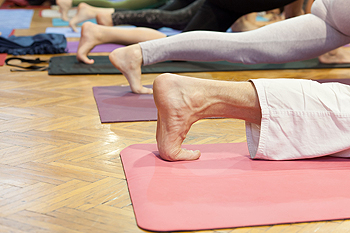 Research has indicated it is easier to run when the feet are healthy. Stretching the feet frequently will help the feet to become strong and may positively affect the overall health of the body. When proper foot stretches are performed, the feet become stable, and running extended distances may be easier to achieve. There are several exercises that are designed to strengthen the feet. When toe curling is practiced, the entire foot becomes stronger, and can be done while standing or sitting down. An effective stretch for the toes is referred to as toe yoga. This is accomplished by moving the toes one at a time and will help in keeping the top of the foot strong. If you would like additional information about the benefits of stretching the feet, it is advised that you speak to a podiatrist who can provide you with the correct knowledge.
Research has indicated it is easier to run when the feet are healthy. Stretching the feet frequently will help the feet to become strong and may positively affect the overall health of the body. When proper foot stretches are performed, the feet become stable, and running extended distances may be easier to achieve. There are several exercises that are designed to strengthen the feet. When toe curling is practiced, the entire foot becomes stronger, and can be done while standing or sitting down. An effective stretch for the toes is referred to as toe yoga. This is accomplished by moving the toes one at a time and will help in keeping the top of the foot strong. If you would like additional information about the benefits of stretching the feet, it is advised that you speak to a podiatrist who can provide you with the correct knowledge.
Why Stretching Is Important for Your Feet
Stretching the feet is a great way to prevent injuries. If you have any concerns with your feet consult with Jim Maxka, DPM from South Penn Foot & Ankle Associates. Our doctor will assess your condition and provide you with quality foot and ankle treatment.
Stretching the Feet
Stretching the muscles in the foot is an important part in any physical activity. Feet that are tight can lead to less flexibility and make you more prone to injury. One of the most common forms of foot pain, plantar fasciitis, can be stretched out to help ease the pain. Stretching can not only ease pain from plantar fasciitis but also prevent it as well. However, it is important to see a podiatrist first to determine if stretching is right for you. Podiatrists can also recommend other ways to stretch your feet. Once you know whether stretching is right for you, here are some excellent stretches you can do.
- Using a foam roller or any cylindrical object (a water bottle or soda can will do), roll the object under your foot back and forth. You should also exert pressure on the object. Be sure to do this to both feet for a minute. Do this exercise three times each.
- Similar to the previous exercise, take a ball, such as a tennis ball, and roll it under your foot while seated and exert pressure on it.
- Grab a resistance band or towel and take a seat. If you are using a towel, fold it length wise. Next put either one between the ball of your foot and heel and pull with both hands on each side towards you. Hold this for 15 seconds and then switch feet. Do this three times for each foot.
- Finally hold your big toe while crossing one leg over the other. Pull the toe towards you and hold for 15 seconds. Once again do this three times per foot.
It is best to go easy when first stretching your foot and work your way up. If your foot starts hurting, stop exercising to ice and rest the foot. It is advised that you then see a podiatrist for help.
If you have any questions, please feel free to contact our office located in Hanover, PA . We offer the newest diagnostic and treatment technologies for all your foot care needs.
Is a Bunion a Permanent Deformity?
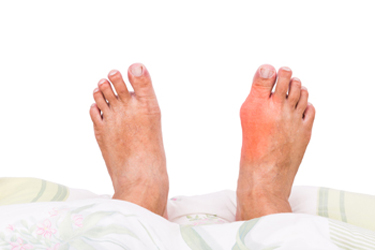 If you notice a bony protrusion that may look like a permanent deformity on the side of your big toe, you may have what is known as a bunion. It may develop as a result of wearing shoes that do not have adequate room for the toes to move freely in, or possibly from a genetic trait. Some of the symptoms that are associated with this condition may be tenderness and swelling, in addition to burning or tingling sensations. If having this ailment interferes with wearing shoes and completing daily activities, many patients may choose to undergo surgery for permanent removal of the bunion. For less severe bunions, orthotics may be prescribed which may provide mild relief. If properly fitting shoes and socks are worn, painful and uncomfortable bunions may possibly be prevented. If you are affected by bunions, it is advised to speak to a podiatrist who can properly diagnosis and offer correct treatment techniques.
If you notice a bony protrusion that may look like a permanent deformity on the side of your big toe, you may have what is known as a bunion. It may develop as a result of wearing shoes that do not have adequate room for the toes to move freely in, or possibly from a genetic trait. Some of the symptoms that are associated with this condition may be tenderness and swelling, in addition to burning or tingling sensations. If having this ailment interferes with wearing shoes and completing daily activities, many patients may choose to undergo surgery for permanent removal of the bunion. For less severe bunions, orthotics may be prescribed which may provide mild relief. If properly fitting shoes and socks are worn, painful and uncomfortable bunions may possibly be prevented. If you are affected by bunions, it is advised to speak to a podiatrist who can properly diagnosis and offer correct treatment techniques.
If you are suffering from bunions, contact Jim Maxka, DPM of South Penn Foot & Ankle Associates. Our doctor can provide the care you need to keep you pain-free and on your feet.
What Is a Bunion?
A bunion is formed of swollen tissue or an enlargement of boney growth, usually located at the base joint of the toe that connects to the foot. The swelling occurs due to the bones in the big toe shifting inward, which impacts the other toes of the foot. This causes the area around the base of the big toe to become inflamed and painful.
Why Do Bunions Form?
Genetics – Susceptibility to bunions are often hereditary
Stress on the feet – Poorly fitted and uncomfortable footwear that places stress on feet, such as heels, can worsen existing bunions
How Are Bunions Diagnosed?
Doctors often perform two tests – blood tests and x-rays – when trying to diagnose bunions, especially in the early stages of development. Blood tests help determine if the foot pain is being caused by something else, such as arthritis, while x-rays provide a clear picture of your bone structure to your doctor.
How Are Bunions Treated?
- Refrain from wearing heels or similar shoes that cause discomfort
- Select wider shoes that can provide more comfort and reduce pain
- Anti-inflammatory and pain management drugs
- Orthotics or foot inserts
- Surgery
If you have any questions, please feel free to contact our office located in Hanover, PA . We offer the newest diagnostic and treatment technologies for all your foot care needs.
Possible Treatment of a Broken Toe
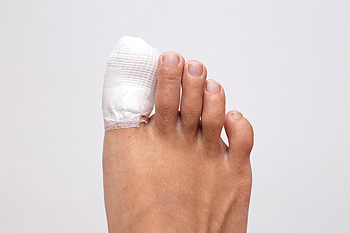 The bones that exist in the toes are fragile and small, and may easily break if a heavy object is dropped on them. Patients may realize their toe may be broken if it appears to be crooked, or if an open wound occurs after the injury happens. Additional symptoms may include pain, difficulty in moving the toe, and swelling. Mild relief may be found while elevating the foot, which may help to decrease swelling. It is suggested to keep the foot as still as possible, and this may be accomplished by resting the foot frequently during the day. Taping the injured toe to the toe next to it may provide stability while the healing process occurs. If you feel you have broken your toe, it is suggested that you consult with a podiatrist who can properly diagnosis and treat this condition.
The bones that exist in the toes are fragile and small, and may easily break if a heavy object is dropped on them. Patients may realize their toe may be broken if it appears to be crooked, or if an open wound occurs after the injury happens. Additional symptoms may include pain, difficulty in moving the toe, and swelling. Mild relief may be found while elevating the foot, which may help to decrease swelling. It is suggested to keep the foot as still as possible, and this may be accomplished by resting the foot frequently during the day. Taping the injured toe to the toe next to it may provide stability while the healing process occurs. If you feel you have broken your toe, it is suggested that you consult with a podiatrist who can properly diagnosis and treat this condition.
A broken toe can be very painful and lead to complications if not properly fixed. If you have any concerns about your feet, contact Jim Maxka, DPM from South Penn Foot & Ankle Associates. Our doctor will treat your foot and ankle needs.
What to Know About a Broken Toe
Although most people try to avoid foot trauma such as banging, stubbing, or dropping heavy objects on their feet, the unfortunate fact is that it is a common occurrence. Given the fact that toes are positioned in front of the feet, they typically sustain the brunt of such trauma. When trauma occurs to a toe, the result can be a painful break (fracture).
Symptoms of a Broken Toe
- Throbbing pain
- Swelling
- Bruising on the skin and toenail
- The inability to move the toe
- Toe appears crooked or disfigured
- Tingling or numbness in the toe
Generally, it is best to stay off of the injured toe with the affected foot elevated.
Severe toe fractures may be treated with a splint, cast, and in some cases, minor surgery. Due to its position and the pressure it endures with daily activity, future complications can occur if the big toe is not properly treated.
If you have any questions please feel free to contact our office located in Hanover, PA . We offer the newest diagnostic and treatment technologies for all your foot and ankle needs.
What Causes Hammertoe?
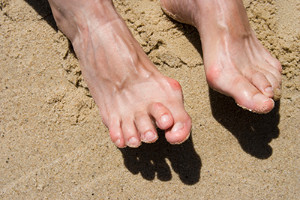 If you notice your middle toes are bent in a downward position, you may have what is referred to as hammertoe. The second toe is typically affected, and it may resemble a hammer as a result of the way it is bent. The most common reasons for hammertoes to develop may be from wearing footwear that does not fit correctly. These may include shoes which do not have ample room for the toes to move freely in. Additional reasons why this condition may develop may be genetic factors, or existing medical conditions which may include bunions or arthritis. Many people experience common symptoms when hammertoe has developed. These may include toe pain when the toes are stretched downward, toes that are curled, or thickened skin on the affected toe and surrounding areas. Hammertoes may be prevented by wearing shoes that fit correctly, and this often means choosing shoes that have adequate room for the toes to move about in. If you have this ailment, please consult with a podiatrist who can discuss proper treatment options with you.
If you notice your middle toes are bent in a downward position, you may have what is referred to as hammertoe. The second toe is typically affected, and it may resemble a hammer as a result of the way it is bent. The most common reasons for hammertoes to develop may be from wearing footwear that does not fit correctly. These may include shoes which do not have ample room for the toes to move freely in. Additional reasons why this condition may develop may be genetic factors, or existing medical conditions which may include bunions or arthritis. Many people experience common symptoms when hammertoe has developed. These may include toe pain when the toes are stretched downward, toes that are curled, or thickened skin on the affected toe and surrounding areas. Hammertoes may be prevented by wearing shoes that fit correctly, and this often means choosing shoes that have adequate room for the toes to move about in. If you have this ailment, please consult with a podiatrist who can discuss proper treatment options with you.
Hammertoes can be a painful condition to live with. For more information, contact Jim Maxka, DPM of South Penn Foot & Ankle Associates. Our doctor will answer any of your foot- and ankle-related questions.
Hammertoe
Hammertoe is a foot deformity that occurs due to an imbalance in the muscles, tendons, or ligaments that normally hold the toe straight. It can be caused by the type of shoes you wear, your foot structure, trauma, and certain disease processes.
Symptoms
- Painful and/or difficult toe movement
- Swelling
- Joint stiffness
- Calluses/Corns
- Physical deformity
Risk Factors
- Age – The risk of hammertoe increases with age
- Sex – Women are more likely to have hammertoe compared to men
- Toe Length – You are more likely to develop hammertoe if your second toe is longer than your big toe
- Certain Diseases – Arthritis and diabetes may make you more likely to develop hammertoe
Treatment
If you have hammertoe, you should change into a more comfortable shoe that provides enough room for your toes. Exercises such as picking up marbles may strengthen and stretch your toe muscles. Nevertheless, it is important to seek assistance from a podiatrist in order to determine the severity of your hammertoe and see which treatment option will work best for you.
If you have any questions, please feel free to contact our office located in Hanover, PA . We offer the newest diagnostic and treatment technologies for all your foot care needs.
How Does an Achilles Tendon Injury Occur?
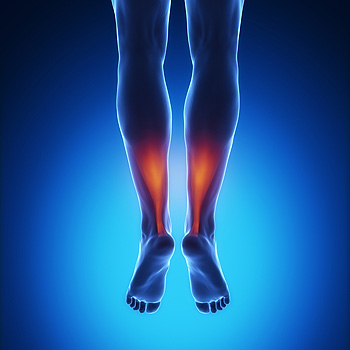 The tendon that connects the heel bone to the calf muscles is referred to as the Achilles tendon. This tendon is responsible for helping the feet push off the ground while walking, running, or jumping. It may become torn as a result of an injury that has happened to it. Many things can cause this to occur, including running uphill, participating in sporting activities that involve sharp turns, or possibly from falling. Some of the symptoms that are associated with this type of injury may include feeling pain and discomfort in the back of your ankle, having difficulty while standing on your tiptoes, or your leg may appear swollen. Mild relief may be found when the affected leg is elevated, and this may be helpful in reducing the swelling. If you have torn your Achilles tendon, it is suggested that you consult with a podiatrist who can offer proper treatment options.
The tendon that connects the heel bone to the calf muscles is referred to as the Achilles tendon. This tendon is responsible for helping the feet push off the ground while walking, running, or jumping. It may become torn as a result of an injury that has happened to it. Many things can cause this to occur, including running uphill, participating in sporting activities that involve sharp turns, or possibly from falling. Some of the symptoms that are associated with this type of injury may include feeling pain and discomfort in the back of your ankle, having difficulty while standing on your tiptoes, or your leg may appear swollen. Mild relief may be found when the affected leg is elevated, and this may be helpful in reducing the swelling. If you have torn your Achilles tendon, it is suggested that you consult with a podiatrist who can offer proper treatment options.
Achilles tendon injuries need immediate attention to avoid future complications. If you have any concerns, contact Jim Maxka, DPM of South Penn Foot & Ankle Associates. Our doctor can provide the care you need to keep you pain-free and on your feet.
What Is the Achilles Tendon?
The Achilles tendon is a tendon that connects the lower leg muscles and calf to the heel of the foot. It is the strongest tendon in the human body and is essential for making movement possible. Because this tendon is such an integral part of the body, any injuries to it can create immense difficulties and should immediately be presented to a doctor.
What Are the Symptoms of an Achilles Tendon Injury?
There are various types of injuries that can affect the Achilles tendon. The two most common injuries are Achilles tendinitis and ruptures of the tendon.
Achilles Tendinitis Symptoms
- Inflammation
- Dull to severe pain
- Increased blood flow to the tendon
- Thickening of the tendon
Rupture Symptoms
- Extreme pain and swelling in the foot
- Total immobility
Treatment and Prevention
Achilles tendon injuries are diagnosed by a thorough physical evaluation, which can include an MRI. Treatment involves rest, physical therapy, and in some cases, surgery. However, various preventative measures can be taken to avoid these injuries, such as:
- Thorough stretching of the tendon before and after exercise
- Strengthening exercises like calf raises, squats, leg curls, leg extensions, leg raises, lunges, and leg presses
If you have any questions please feel free to contact our office located in Hanover, PA . We offer the newest diagnostic tools and technology to treat your foot and ankle needs.
Possible Causes of Morton’s Neuroma
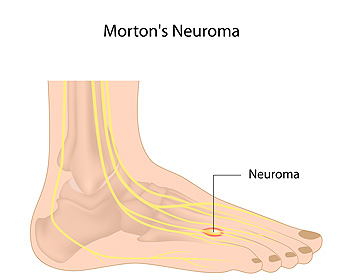 The pain and discomfort that is typically associated with Morton’s neuroma is located on the ball of the foot. Many patients may notice swelling and feel a burning sensation in that area of the foot, and it may affect the way you walk. It generally occurs as a result of a thickened nerve that leads to the toes. This may happen from wearing shoes that are too tight and may cause the affected nerve to become irritated. There may be other causes of Morton’s neuroma, and these may include having flat feet, or medical conditions such as hammer toes or bunions. It is important to have a proper diagnosis performed. This can be accomplished by having an X-ray taken, which may be helpful in eliminating other conditions that may exist. If you feel you have this condition, it is advised to consult with a podiatrist who can suggest wearing insoles or recommend foot strengthening exercises.
The pain and discomfort that is typically associated with Morton’s neuroma is located on the ball of the foot. Many patients may notice swelling and feel a burning sensation in that area of the foot, and it may affect the way you walk. It generally occurs as a result of a thickened nerve that leads to the toes. This may happen from wearing shoes that are too tight and may cause the affected nerve to become irritated. There may be other causes of Morton’s neuroma, and these may include having flat feet, or medical conditions such as hammer toes or bunions. It is important to have a proper diagnosis performed. This can be accomplished by having an X-ray taken, which may be helpful in eliminating other conditions that may exist. If you feel you have this condition, it is advised to consult with a podiatrist who can suggest wearing insoles or recommend foot strengthening exercises.
Morton’s neuroma is a very uncomfortable condition to live with. If you think you have Morton’s neuroma, contact Jim Maxka, DPM of South Penn Foot & Ankle Associates. Our doctor will attend to all of your foot care needs and answer any of your related questions.
Morton’s Neuroma
Morton's neuroma is a painful foot condition that commonly affects the areas between the second and third or third and fourth toe, although other areas of the foot are also susceptible. Morton’s neuroma is caused by an inflamed nerve in the foot that is being squeezed and aggravated by surrounding bones.
What Increases the Chances of Having Morton’s Neuroma?
- Ill-fitting high heels or shoes that add pressure to the toe or foot
- Jogging, running or any sport that involves constant impact to the foot
- Flat feet, bunions, and any other foot deformities
Morton’s neuroma is a very treatable condition. Orthotics and shoe inserts can often be used to alleviate the pain on the forefront of the feet. In more severe cases, corticosteroids can also be prescribed. In order to figure out the best treatment for your neuroma, it’s recommended to seek the care of a podiatrist who can diagnose your condition and provide different treatment options.
If you have any questions, please feel free to contact our office located in Hanover, PA . We offer the newest diagnostic and treatment technologies for all your foot care needs.
The Three Stages of Ingrown Toenails
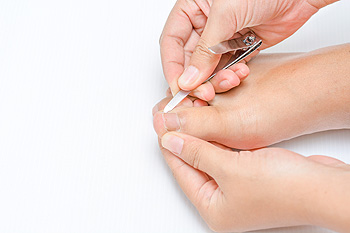 Ingrown toenails are uncomfortable and can sometimes make it painful to walk. Common causes for this condition include ill-fitting shoes, injury, excessively sweaty feet, and thick or curved nails. Once they have started to form, ingrown toenails can go through three stages. Stage 1 begins with the initial inflammation and is followed by moderate pain, swelling, redness, and visible fluid accumulation. Stage 2 occurs if the symptoms begin to worsen. Signs that the nail is entering stage 2 are increased pain and pus discharge from the wound. Stage 3 is the most severe form of an ingrown toenail and requires medical attention in order to be treated. In stage 3, new tissue can form over the wound, which can easily intensify the infection. It’s important to begin treating an ingrown toenail as soon as you notice any symptoms, so you can avoid progression into stage 3. If you have an ingrown toenail, it is recommended you consult with a podiatrist to learn about treatment options.
Ingrown toenails are uncomfortable and can sometimes make it painful to walk. Common causes for this condition include ill-fitting shoes, injury, excessively sweaty feet, and thick or curved nails. Once they have started to form, ingrown toenails can go through three stages. Stage 1 begins with the initial inflammation and is followed by moderate pain, swelling, redness, and visible fluid accumulation. Stage 2 occurs if the symptoms begin to worsen. Signs that the nail is entering stage 2 are increased pain and pus discharge from the wound. Stage 3 is the most severe form of an ingrown toenail and requires medical attention in order to be treated. In stage 3, new tissue can form over the wound, which can easily intensify the infection. It’s important to begin treating an ingrown toenail as soon as you notice any symptoms, so you can avoid progression into stage 3. If you have an ingrown toenail, it is recommended you consult with a podiatrist to learn about treatment options.
Ingrown toenails may initially present themselves as a minor discomfort, but they may progress into an infection in the skin without proper treatment. For more information about ingrown toenails, contact Jim Maxka, DPM of South Penn Foot & Ankle Associates. Our doctor can provide the care you need to keep you pain-free and on your feet.
Ingrown Toenails
Ingrown toenails are caused when the corner or side of a toenail grows into the soft flesh surrounding it. They often result in redness, swelling, pain, and in some cases, infection. This condition typically affects the big toe and may recur if it is not treated properly.
Causes
- Improper toenail trimming
- Genetics
- Improper shoe fitting
- Injury from pedicures or nail picking
- Abnormal gait
- Poor hygiene
You are more likely to develop an ingrown toenail if you are obese, have diabetes, arthritis, or have any fungal infection in your nails. Additionally, people who have foot or toe deformities are at a higher risk of developing an ingrown toenail.
Symptoms
Some symptoms of ingrown toenails are redness, swelling, and pain. In rare cases, there may be a yellowish drainage coming from the nail.
Treatment
Ignoring an ingrown toenail can have serious complications. Infections of the nail border can progress to a deeper soft-tissue infection, which can then turn into a bone infection. You should always speak with your podiatrist if you suspect you have an ingrown toenail, especially if you have diabetes or poor circulation.
If you have any questions, please feel free to contact our office located in Hanover, PA . We offer the newest diagnostic and treatment technologies for all your foot care needs.
What Is a Blister?
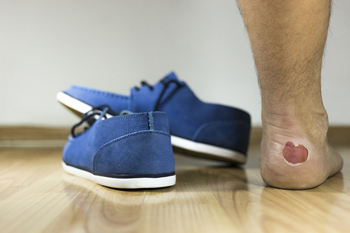 Patients who have suffered from blisters are familiar with the pain and discomfort they may cause. They may develop as a result of increased friction on a portion of the skin, which may come from wearing shoes or socks that fit improperly. When the skin becomes exposed, a blister will form as part of the body’s natural defense mechanism. This consists of a pocket of fluid which protects the affected area of skin. Additional reasons why blisters may develop may include allergic reactions to a bee sting or insect bite, or neuropathy which may originate from diabetes. If neuropathy is present, it may cause the patient to be unaware of existing blisters, and this may be a result of the inability to sense discomfort. When new skin begins to grow under the blister, it will generally drain on its own. If you have a blister on your foot that has become infected, it is suggested to speak to a podiatrist who can properly assist you in obtaining the correct treatment.
Patients who have suffered from blisters are familiar with the pain and discomfort they may cause. They may develop as a result of increased friction on a portion of the skin, which may come from wearing shoes or socks that fit improperly. When the skin becomes exposed, a blister will form as part of the body’s natural defense mechanism. This consists of a pocket of fluid which protects the affected area of skin. Additional reasons why blisters may develop may include allergic reactions to a bee sting or insect bite, or neuropathy which may originate from diabetes. If neuropathy is present, it may cause the patient to be unaware of existing blisters, and this may be a result of the inability to sense discomfort. When new skin begins to grow under the blister, it will generally drain on its own. If you have a blister on your foot that has become infected, it is suggested to speak to a podiatrist who can properly assist you in obtaining the correct treatment.
Blisters are prone to making everyday activities extremely uncomfortable. If your feet are hurting, contact Jim Maxka, DPM of South Penn Foot & Ankle Associates. Our doctor can provide the care you need to keep you pain-free and on your feet.
Foot Blisters
Foot blisters develop as a result of constantly wearing tight or ill-fitting footwear. This happens due to the constant rubbing from the shoe, which can often lead to pain.
What Are Foot Blisters?
A foot blister is a small fluid-filled pocket that forms on the upper-most layer of the skin. Blisters are filled with clear fluid and can lead to blood drainage or pus if the area becomes infected.
How Do Blisters Form?
Blisters on the feet are often the result of constant friction of skin and material, usually by shoe rubbing. Walking in sandals, boots, or shoes that don’t fit properly for long periods of time can result in a blister. Having consistent foot moisture and humidity can easily lead to blister formation.
Prevention & Treatment
It is important to properly care for the affected area in order to prevent infection and ease the pain. Do not lance the blister and use a Band-Aid to provide pain relief. Also, be sure to keep your feet dry and wear proper fitting shoes. If you see blood or pus in a blister, seek assistance from a podiatrist.
If you have any questions, please feel free to contact our office located in Hanover, PA . We offer the newest diagnostic and treatment technologies for all your foot care needs.
Blisters on the Feet
Blisters are a common ailment of people who wear shoes that are either too tight or rub against the feet in an uncomfortable way. Knowing the basics of blisters is important for understanding how they are formed and what treatments should be used for them.
A blister on the foot, or any other part of the body, is a small pocket that is filled with fluid. It usually forms on the upper layer of the skin because these layers are loose enough to allow a blister to form. The most common fluid in a blister is just a clear, watery-like fluid that usually isn’t cause for concern. However, blisters can fill up with blood if they are deep enough and pus if they have become infected with bacteria.
Blisters almost always form on the feet due to shoes rubbing up against the foot, where the friction causes blisters. These can occur after you have walked for a long period of time or when your shoes do not fit you properly. Your feet are also more prone to blisters if they are moist, so keeping them dry and clean is one preventative step you can take.
Preventing infection should be the number one concern when treating blisters, as well as relieving the pain they can cause. Using a bandage to cover up the blister will help it heal and prevent bacteria from entering it. New skin will form under the blister and eventually cause it to pop. You can also take a sterilized pin and try to pop it yourself.
If the blister is filled with pus or blood, seeking treatment from a doctor is ideal. Antibiotics may need to be taken in order to completely eliminate the bacteria inside the blister. See a doctor to have an antibiotic prescribed.
The best way to treat blisters is to prevent them all together. Keeping your feet dry and making sure that your shoes fit properly are just two of the steps you can take to prevent blisters. Shoes that are too tight or shoes that are too loose and allow your feet to slide in them will cause blisters. Applying a bandage to an area where you think a blister is about to form is another way you can prevent them.
Causes of Heel Pain
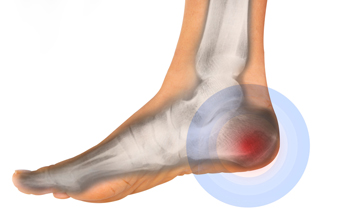 Many patients suffer from heel pain, and there may be several reasons why this may occur. These may include injuries to the foot that involves the heel, chronic conditions such as plantar fasciitis, bruises or stress fractures. Achilles tendonitis may develop as result of overuse, which may happen while participating in sporting activities. A heel pad bruise may occur as a result of wearing shoes that do not have adequate cushioning. It may also occur from falling from a high distance and landing on the heel. A condition that is known as haglund’s syndrome may occur if a bony protrusion develops on the back of the heel as it rubs against shoes that are stiff. Symptoms of this may include pain in the heel area of the foot, and possible swelling. If you are experiencing any type of heel pain, it is strongly suggested that you seek the counsel of a podiatrist who can properly diagnose and treat heel pain.
Many patients suffer from heel pain, and there may be several reasons why this may occur. These may include injuries to the foot that involves the heel, chronic conditions such as plantar fasciitis, bruises or stress fractures. Achilles tendonitis may develop as result of overuse, which may happen while participating in sporting activities. A heel pad bruise may occur as a result of wearing shoes that do not have adequate cushioning. It may also occur from falling from a high distance and landing on the heel. A condition that is known as haglund’s syndrome may occur if a bony protrusion develops on the back of the heel as it rubs against shoes that are stiff. Symptoms of this may include pain in the heel area of the foot, and possible swelling. If you are experiencing any type of heel pain, it is strongly suggested that you seek the counsel of a podiatrist who can properly diagnose and treat heel pain.
Many people suffer from bouts of heel pain. For more information, contact Jim Maxka, DPM of South Penn Foot & Ankle Associates. Our doctor can provide the care you need to keep you pain-free and on your feet.
Causes of Heel Pain
Heel pain is often associated with plantar fasciitis. The plantar fascia is a band of tissues that extends along the bottom of the foot. A rip or tear in this ligament can cause inflammation of the tissue.
Achilles tendonitis is another cause of heel pain. Inflammation of the Achilles tendon will cause pain from fractures and muscle tearing. Lack of flexibility is also another symptom.
Heel spurs are another cause of pain. When the tissues of the plantar fascia undergo a great deal of stress, it can lead to ligament separation from the heel bone, causing heel spurs.
Why Might Heel Pain Occur?
- Wearing ill-fitting shoes
- Wearing non-supportive shoes
- Weight change
- Excessive running
Treatments
Heel pain should be treated as soon as possible for immediate results. Keeping your feet in a stress-free environment will help. If you suffer from Achilles tendonitis or plantar fasciitis, applying ice will reduce the swelling. Stretching before an exercise like running will help the muscles. Using all these tips will help make heel pain a condition of the past.
If you have any questions please contact our office located in Hanover, PA . We offer the newest diagnostic and treatment technologies for all your foot and ankle needs.









